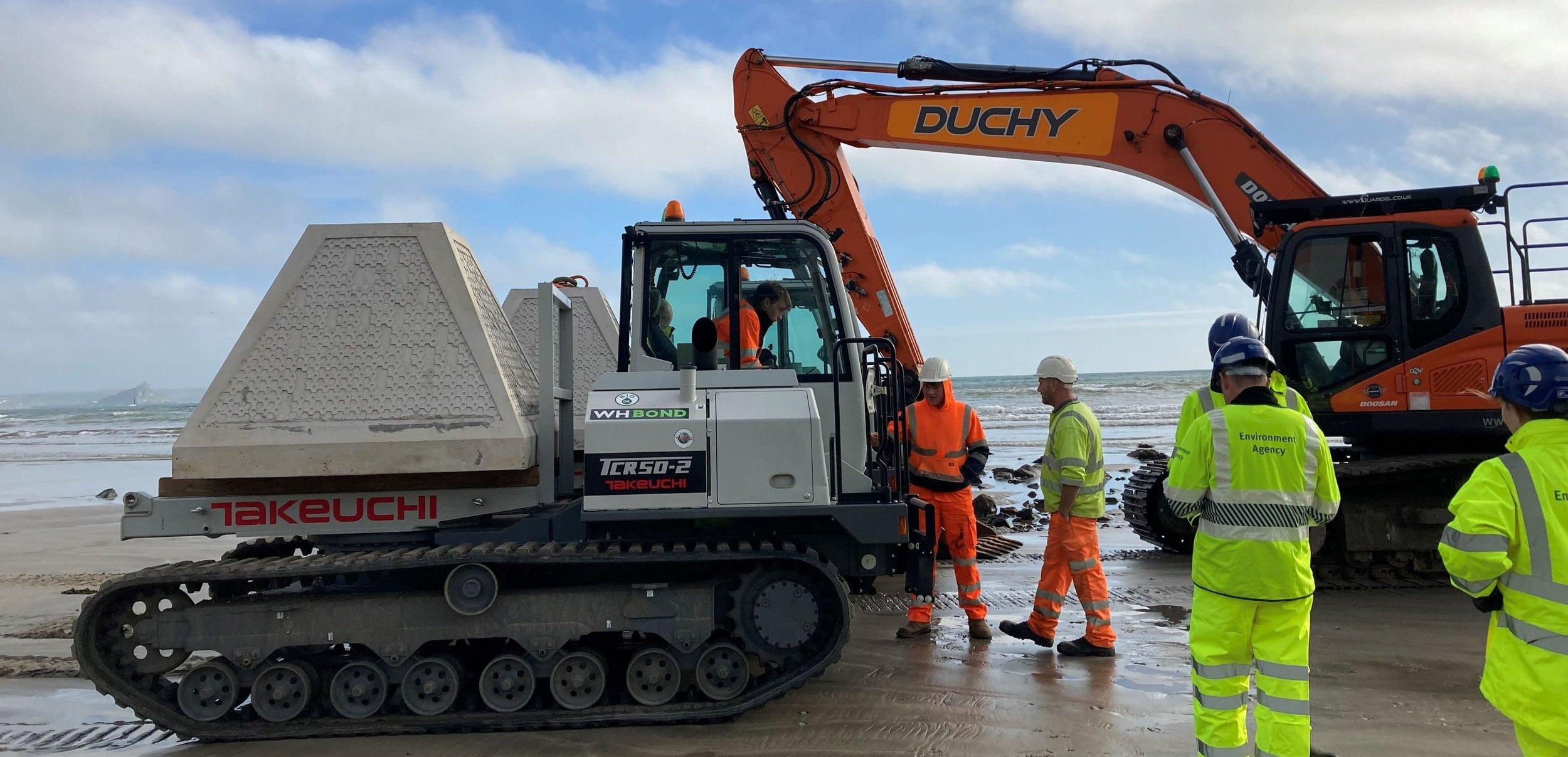Newlyn, UK - Environment Agency
What / where is the pilot?
The Newlyn Eco-Block Research pilot is located adjacent to Newlyn Harbour, Mount’s Bay in Cornwall, UK. The pilot project involves deploying low-carbon eco-blocks on and around an existing breakwater, to research a more nature-based solution to coastal defence which could deliver multiple benefits. It is anticipated that this location will enable trials of the new blocks in a high wave energy intertidal environment. The findings from the pilot project will inform applications for the blocks in future breakwater construction projects around the coast to assist in managing climate change-induced risks from coastal erosion and flooding. A number of different suppliers of eco-block products have been used in the pilot, each of which aim to provide a bespoke substrate for marine organisms to colonise and develop living structures.
Why is the pilot needed and what are the benefits?
Historically, this area has relied primarily on land-based static and inflexible protection. This is in response to the flood and erosion risks which exist throughout Mount’s Bay, as well as across the wider coastline of Cornwall, which are further intensified by the effects of climate change and sea level rise. As such, the local shoreline is heavily developed and structures modify the natural coastal system rather than work with it. The Newlyn Eco-Block Research pilot is trialling engineering products that could be used in the future to reduce wave energy at the shoreline and promote growth of natural beaches behind, creating a wider risk management zone. The eco-blocks have been designed with surface texturing inspired by natural nearshore rocky habitat and features shaped to encourage colonisation by algae and other marine life, to improve local marine biodiversity. The over-arching aim is to demonstrate an approach which is more adaptive and environmentally beneficial in the longer-term.
How is the pilot using Nature-based solutions?
The intention of the pilot is to complement the natural nearshore rocky outcrops which exist within the local area by using products that have been designed with features such as rockpools, crevices and rough surface textures. The innovative, low-carbon materials and block designs will also test emerging ideas on ‘greening-up’ more traditional types of hard coastal infrastructure. The Newlyn Eco-Block Research pilot will deliver an opportunity to gain experience of how Nature Based Solutions can address problems experienced in high wave energy environments. By deploying and monitoring a variety of eco-blocks, it is intended to establish which properties such as substrate material, habitat features and block position give the best chance of marine organism colonisation in this type of environment, whilst also being suitable for the construction of reefs and breakwaters. It is intended that the results will inform the design of future coastal defences which will become living structures, harnessing the adaptive capacity of natural coastal processes.
Mini eco-block trial
In early November 2020, the Environment Agency, Exo Environmental and contractors met at the pilot site in Newlyn to deploy 12 trial eco-blocks and complete baseline monitoring. The Newlyn Eco-Block Research project is one of several pilot projects being delivered by Sustainable And Resilient Coastal Cities (SARCC) which is trialling nature-based solutions to address climate change and sea level rise. The prototype blocks, each weighing around 75kg, are manufactured from a granitic particulate by-product, sourced from a local quarry stockpile. The trial was carried out to help us identify optimal surface textures for larger eco-blocks to be used in the full-scale pilot. Ecological monitoring was then carried out by the Environment Agency over the next 24 months to determine colonisation rates and species type.
By July 2022 the trial eco-blocks had developed a good coverage of algae including gut weed and spiral wrack. Species of periwinkle and limpet were also recorded on the blocks, using the textured surfaces for shelter, with sea slaters, barnacles, toothed topshells, mussels and anemone also being recorded in autumn 2022.
The project team continued to work on plans for the full-scale pilot. The necessary planning permission and marine licence were obtained from the Local Planning Authority and Marine Management Organisation respectively. The Environment Agency and partners at Atkins and Kier worked to select a range of eco-block products from different suppliers for use in the full-scale pilot. These eco-blocks are each around 4.8 tonnes and are made using recycled and low carbon materials.
Pilot construction
During winter 2022/23 a total of 88 new eco-blocks were installed on and around the existing granite breakwater at Newlyn. The eco-blocks are being trialled as a form of coastal protection which also acts as habitat for marine life and is made using low carbon and recycled materials. These characteristics set eco-blocks apart from materials such as traditional concrete and quarried granite, which are more commonly used to build coastal structures but have a larger carbon footprint and offer fewer benefits for wildlife. The pilot includes 4 different suppliers: ARC Marine, ECOncrete, Exo Engineering and JP Concrete. Each eco-block design featuring a variety of habitat niches, pools, surface textures and altered surface pH to encourage rapid colonisation by marine life. After just a few weeks, the project team were pleased to see that the eco-blocks were already being colonised by marine life including algae, snails and limpets.
The Environment Agency will continue to monitor the performance of the eco-blocks and will share the results with the public and other coastal authorities. It is hoped that the findings from this work will help inform future flood and coastal risk management projects where eco-blocks could be a potential solution.









